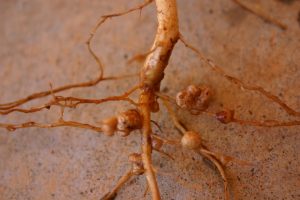What is Nitrogen Fixation?
Nitrogen fixation is the conversion of dinitrogen, which is an inert gas, to reduced forms of nitrogen that are biologically available. This chemical reaction is an important process that regulates the nitrogen cycle and nitrogen availability in soil; it is performed by specialized bacteria, either in symbiosis with plant hosts or as free-living cells. Rhizobia are a general term for the types of bacteria that associate with legume plants to form nodules on roots, where nitrogen fixation occurs. Legumes and rhizobia can be used in a crop rotation to enhance nitrogen cycling in soils and reduce or replace synthetic fertilizer additions.
Do you have an excellent resource that isn’t listed here? Submit it for consideration.
| Title | Source | Resource type and Date | Short Summary / Preview |
|---|---|---|---|
| Legume life cycle and characteristics | University of Minnesota | Extension Webpage
2018 |
Summary of legume life cycles, N fixation and transfer to other plants. |
| Are we making selfish microbes? | Long Term Ecological Research Network | Research Summary
Dec 2016 |
When exposed to nitrogen fertilizer over a period of years, nitrogen-fixing bacteria called rhizobia evolve to become less beneficial to legumes – the plants they normally serve. |
| Worldwide, the Nitrogen Cycle is Off | Michigan State University | Research Summary
Not Dated |
When exposed to nitrogen fertilizer over a period of years, nitrogen-fixing bacteria called rhizobia evolve to become less beneficial to legumes – the plants they normally serve. |
| Purdue scientists show how soybeans may get more nitrogen from atmosphere | Purdue University | Research Summary
Jul 2019 |
Plant breeders could theoretically increase soybean crop yields if they could control the number of nodules on plant roots since they are responsible for fixing atmospheric nitrogen. |
| The Science of Soil Health: Understanding the Value of Legumes and Nitrogen-Fixing Microbes | USDA-NRCS | Video
May 2014 |
Legumes in cash crops and cover crops use natural symbiotic relationships with rhizobia to get nitrogen into the soil. North Carolina State University’s Dr. Julie Grossman is working to unlock the secrets in the soil and to provide farmers with new insights on how to harness this natural resource. |
| Nitrogen in the Environment: Nitrogen Fixation |
University of Missouri | Extension Webpage
Oct 1993 |
An overview of nitrogen fixation. |
| Title | Source | Resource type and date | Short Summary |
|---|---|---|---|
| Legume Seed Inoculants | Colorado State University | Extension Fact Sheet
Sep 2014 |
Inoculation is the process of introducing commercially prepared rhizobia bacteria into the soil. |
| Inoculation of Pulse Crops | Montana State University | Extension Webpage
2018 |
The symbiotic relationship between the plant and the rhizobium to fix nitrogen starts after the seed has germinated. Fifty to 80 percent of the nitrogen requirement of pulse crops can be synthesized through the nitrogen fixation process. |
| Nitrogen Fixation by Legumes | New Mexico State University | Extension Webpage
Jun 2015 |
Biological nitrogen fixation is the process that changes inert N2 into biologically useful NH3. This process is mediated in nature only by N-fixing rhizobia bacteria |
| Nitrogen fixing bacteria | SoilHealth.com | Webpage
Not Dated |
This site addresses 5 questions: (1) What are rhizobia? (2) How are nodules formed in the roots of legumes? (3) Why are nodules pink? (4) What are some other plant-bacterial associations that fix atmospheric nitrogen? (5) Are there bacteria in soil that can fix atmospheric nitrogen without being in a symbiosis with a legume? |
| Nitrogen Fixation | Texas A&M | Extension Webpage
Not Dated |
The nitrogen fixation (N2-fixation) process between the legume plant and rhizobia bacteria is referred to as a symbiotic (mutually beneficial) relationship. Each organism receives something from the other and gives back something in return. |
| Soil Inoculants | University of Georgia | Extension Webpage
Aug 2017 |
Inoculants are used for a variety of reasons. In some cases, we add soil organisms that have a known beneficial effect. For example, some bacteria, like rhizobia, form a symbiotic relationship with certain host plants, like legumes. |
| Title | Source | Resource type and Date | Short Summary |
|---|---|---|---|
| Synchrony of N Supply and Demand | Nutrient Cycling in Agroecosystems | Peer-Reviewed Publication
Jun 2005 |
A research review summarizing when N is needed by the crop and when N is supplied by fertilizer or legumes. |
| Nitrogen Delivery from Legume Cover Crops in No-Till Organic Corn Production | Agronomy Journal | Peer-Reviewed Publication
Nov 2011 |
Study analyzed different legume cover crop abilities to capture N and subsequent organic no-till corn yield in North Carolina. Should go to management section once it exists! |
Last reviewed February 29, 2020
